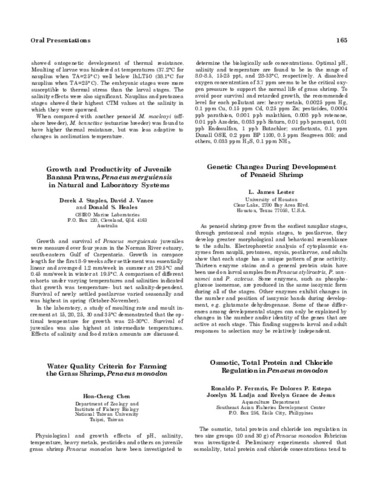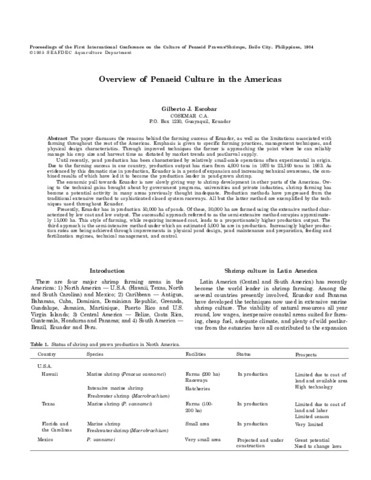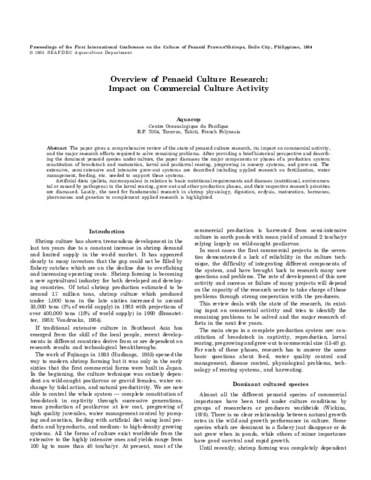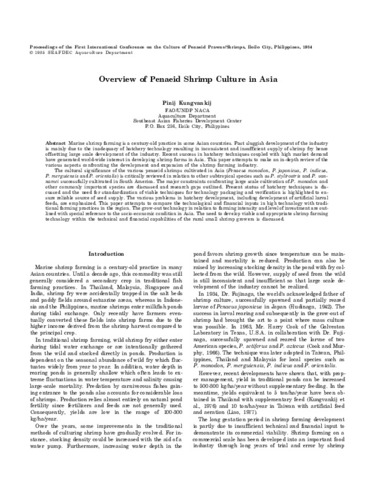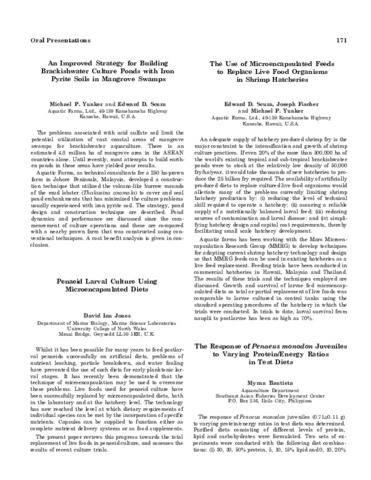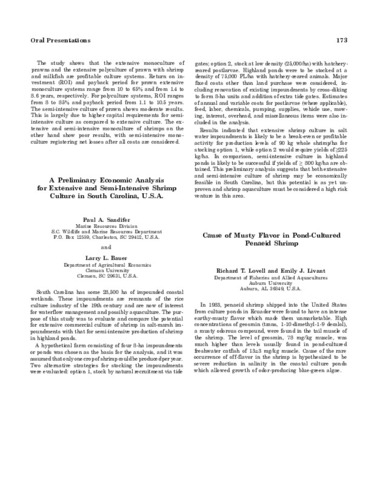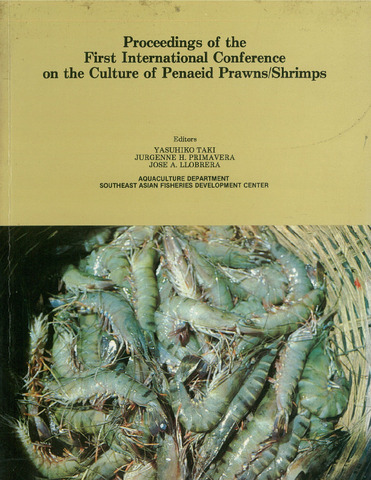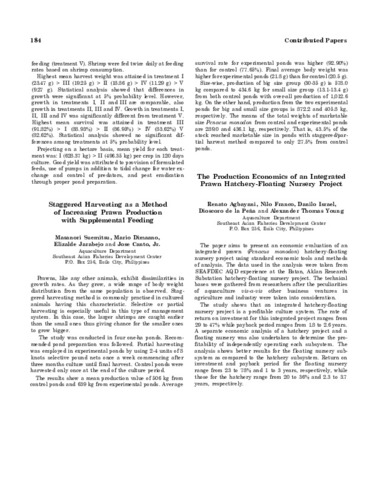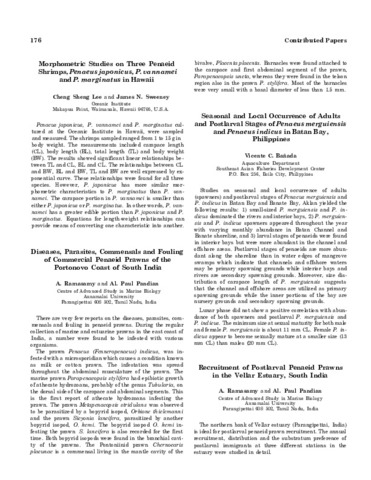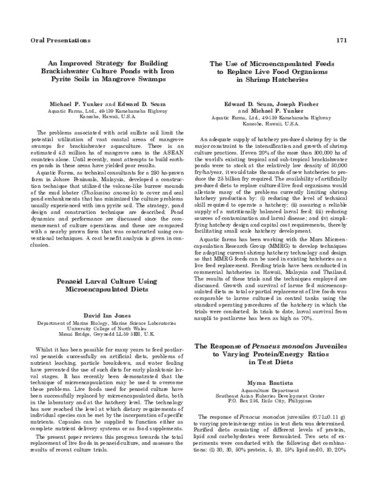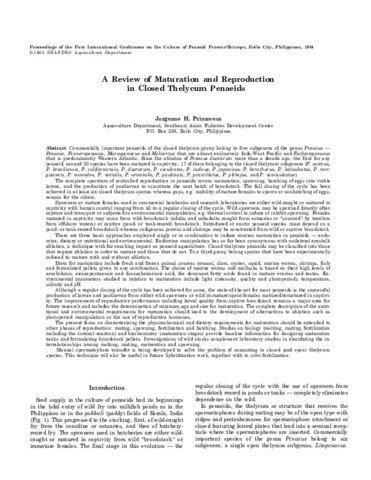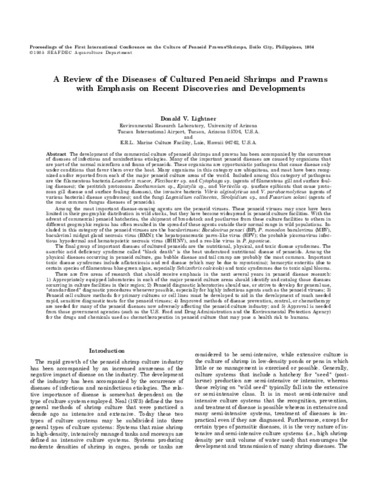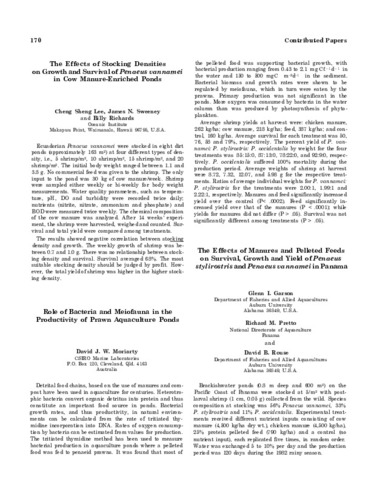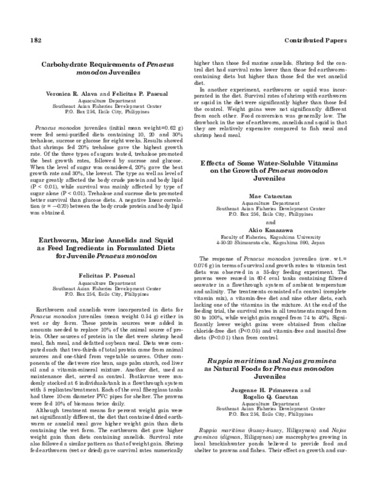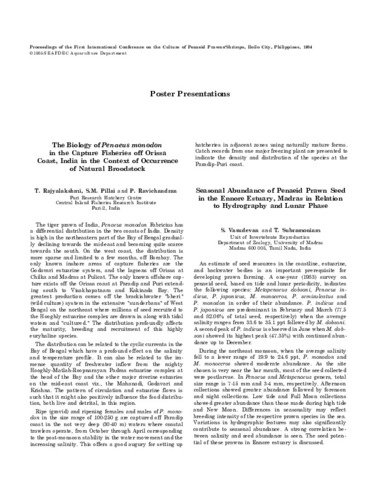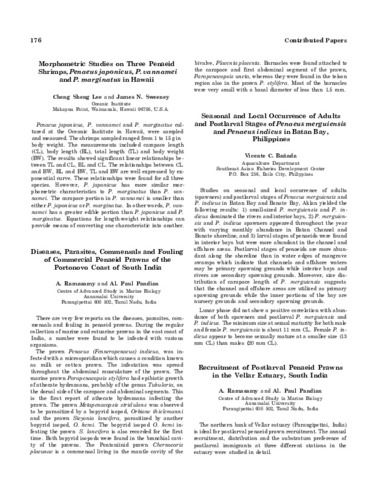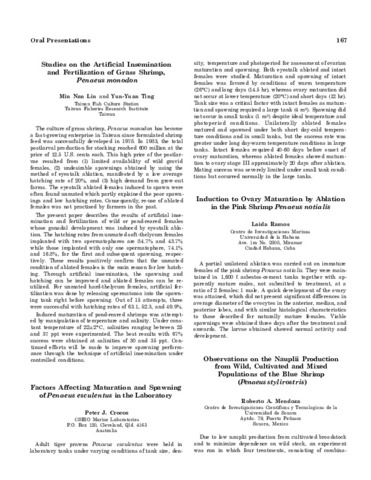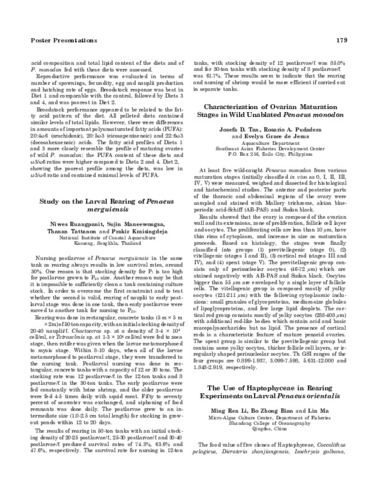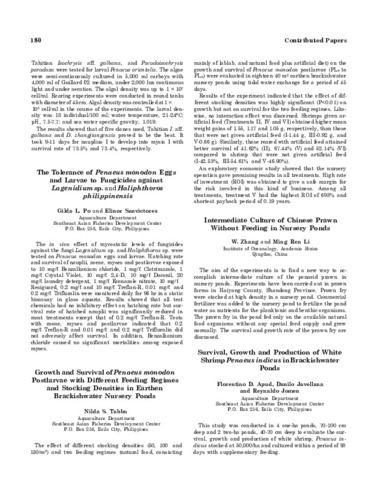Mencari Proceedings of the First International Conference on the Culture of Penaeid Prawns/Shrimps berdasarkan Judul
Now showing items 54-73 of 79
-
Osmotic, total protein and chloride regulation in Penaeus monodon
(Aquaculture Department, Southeast Asian Fisheries Development Center, 1985)The osmotic, total protein and chloride ion regulation in two size groups (10 and 30 g) of Penaeus monodon Fabricius was investigated. Preliminary experiments showed that osmolality, total protein and chloride concentrations ... -
Overview of penaeid culture in the Americas
(Aquaculture Department, Southeast Asian Fisheries Development Center, 1985)The paper discusses the reasons behind the farming success of Ecuador, as well as the limitations associated with farming throughout the rest of the Americas. Emphasis is given to specific farming practices, management ... -
Overview of penaeid culture research: Impact on commercial culture activity
(Aquaculture Department, Southeast Asian Fisheries Development Center, 1985)The paper gives a comprehensive review of the state of penaeid culture research, its impact on commercial activity, and the major research efforts required to solve remaining problems. After providing a brief historical ... -
Overview of penaeid shrimp culture in Asia
(Aquaculture Department, Southeast Asian Fisheries Development Center, 1985)Marine shrimp farming is a century-old practice in some Asian countries. Past sluggish development of the industry is mainly due to the inadequacy of hatchery technology resulting in inconsistent and insufficient supply ... -
Penaeid larval culture using microencapsulated diets
(Aquaculture Department, Southeast Asian Fisheries Development Center, 1985)Whilst it has been possible for many years to feed postlar-val penaeids successfully on artificial diets, problems of nutrient leaching, particle breakdown, and water fouling have prevented the use of such diets for early ... -
A preliminary economic analysis for extensive and semi-intensive shrimp culture in South Carolina, U.S.A.
(Aquaculture Department, Southeast Asian Fisheries Development Center, 1985)South Carolina has some 28,500 ha of impounded coastal wetlands. These impoundments are remnants of the rice culture industry of the 19th century and are now of interest for waterflow management and possibly aquaculture. ... -
Proceedings of the First International Conference on the Culture of Penaeid Prawns/Shrimps, Iloilo City, Philippines, 4-7 December 1984
(Aquaculture Department, Southeast Asian Fisheries Development Center, 1985)Abstracts of the 78 papers presented at the conference are cited individually. -
The production economics of an integrated prawn hatchery-floating nursery project
(Aquaculture Department, Southeast Asian Fisheries Development Center, 1985)The paper aims to present an economic evaluation of an integrated prawn (Penaeus monodon) hatchery-floating nursery project using standard economic tools and methods of analysis. The data used in the analysis were taken ... -
Recruitment of postlarval penaeid prawns in the Vellar estuary, South India
(Aquaculture Department, Southeast Asian Fisheries Development Center, 1985)The northern bank of Vellar estuary (Parangipettai, India) is ideal for postlarval penaeid prawn recruitment. The annual recruitment, distribution and the substratum preference of postlarval immigrants at three different ... -
The response of Penaeus monodon juveniles to varying protein/energy ratios in test diets
(Aquaculture Department, Southeast Asian Fisheries Development Center, 1985)The response of Penaeus monodon juveniles (0.71±0.11 g) to varying protein/energy ratios in test diets was determined. Purified diets consisting of different levels of protein, lipid and carbohydrates were formulated. Two ... -
A review of maturation and reproduction in closed thelycum penaeids
(Aquaculture Department, Southeast Asian Fisheries Development Center, 1985)Commercially important penaeids of the closed thelycum group belong to five subgenera of the genus Penaeus — Penaeus, Fenneropenaeus, Marsupenaeus and Melicertus that are almost exclusively Indo-West Pacific and Farfantepenaeus ... -
A review of the diseases of cultured penaeid shrimps and prawns with emphasis on recent discoveries and developments
(Aquaculture Department, Southeast Asian Fisheries Development Center, 1985)The development of the commercial culture of penaeid shrimps and prawns has been accompanied by the occurrence of diseases of infectious and noninfectious etiologies. Many of the important penaeid diseases are caused by ... -
Role of bacteria and meiofauna in the productivity of prawn aquaculture ponds
(Aquaculture Department, Southeast Asian Fisheries Development Center, 1985)Detrital food chains, based on the use of manures and compost have been used in aquaculture for centuries. Heterotrophic bacteria convert organic detritus into protein and thus constitute an important food source in ponds. ... -
Ruppia maritima and Najas graminea as natural foods for Penaeus monodon juveniles
(Aquaculture Department, Southeast Asian Fisheries Development Center, 1985)Ruppia maritima (kusay-kusay, Hiligaynon) and Najas graminea (digman, Hiligaynon) are macrophytes growing in local brackishwater ponds believed to provide food and shelter to prawns and fishes. Their effect on growth and ... -
Seasonal abundance of Penaeid prawn seed in the Ennore estuary, Madras in relation to hydrography and lunar phase
(Aquaculture Department, Southeast Asian Fisheries Development Center, 1985)An estimate of seed resources in the coastline, estuarine, and backwater bodies is an important prerequisite for developing prawn farming. A one-year (1983) survey on penaeid seed, based on tide and lunar periodicity, ... -
Seasonal and local occurrence of adults and postlarval stages of Penaeus merguiensis and Penaeus indicus in Batan bay, Philippines
(Aquaculture Department, Southeast Asian Fisheries Development Center, 1985)Studies on seasonal and local occurrence of adults (spawners) and postlarval stages of Penaeus merguiensis and P. indicus in Batan Bay and Banate Bay, Aklan yielded the following results: 1) small-sized P. merguiensis and ... -
Staggered harvesting as a method of increasing prawn production with supplemental feeding
(Aquaculture Department, Southeast Asian Fisheries Development Center, 1985)Prawns, like any other animals, exhibit dissimilarities in growth rates. As they grow, a wide range of body weight distribution from the same population is observed. Staggered harvesting method is commonly practised in ... -
Studies on the artificial insemination and fertilization of grass shrimp, Penaeus monodon
(Aquaculture Department, Southeast Asian Fisheries Development Center, 1985)The culture of grass shrimp, Penaeus monodon has become a fast-growing enterprise in Taiwan since formulated shrimp feed was successfully developed in 1978. In 1983, the total postlarval production for stocking reached 600 ... -
Study on the larval rearing of Penaeus merguiensis
(Aquaculture Department, Southeast Asian Fisheries Development Center, 1985)Nursing postlarvae of Penaeus merguiensis in the same tank as rearing always results in low survival rates, around 30%. One reason is that stocking density for P1 is too high for postlarvae grown to P20 size. Another reason ... -
Survival, growth and production of white shrimp Penaeus indicus in brackishwater ponds
(Aquaculture Department, Southeast Asian Fisheries Development Center, 1985)This study was conducted in 4 one-ha ponds, 70-100 cm deep and 2 two-ha ponds, 40-70 cm deep to evaluate the survival, growth and production of white shrimp, Penaeus indicus stocked at 50,000/ha and cultured within a period ...

